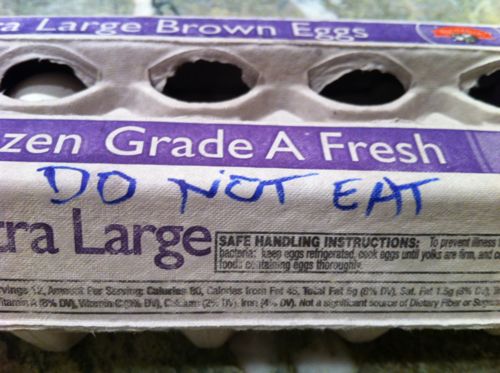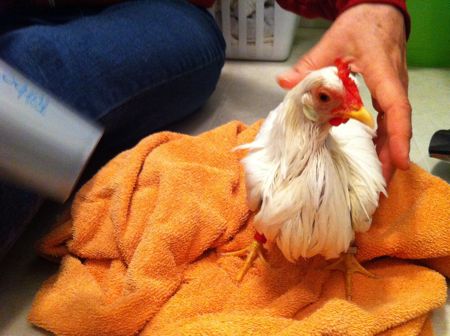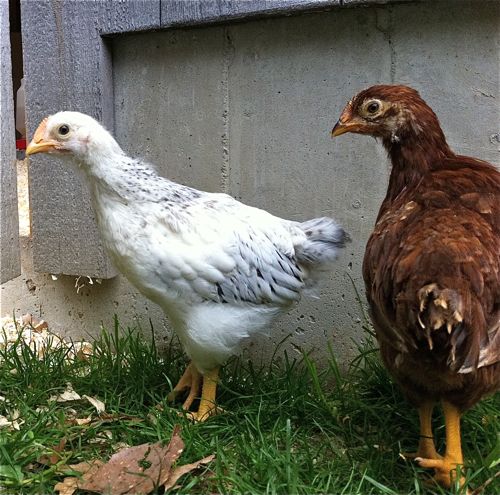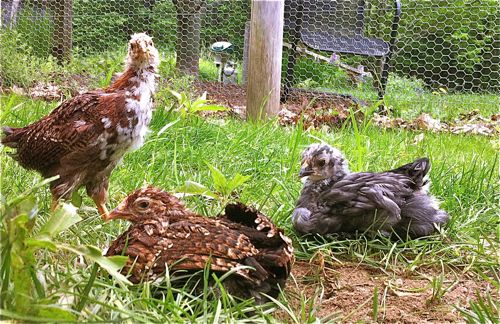There’s always something going on here, but I’m hoping that we’ve seen the end of the major storyline of the last two weeks – the outbreak of a deadly respiratory disease in the HenCam flock.
Among domestic farm animals, contagious diseases can hit fast, spread even as you isolate the first animal that shows the symptoms, and kills before you have a chance to weigh your options. Ask a farmer. Everyone has a story to tell. Backyard flocks are not immune. Wild birds fly in and out of the coops, snatch food from the feeders and leave bacteria, viruses and parasites behind. Factory farmers use this as an excuse to confine birds indoors, but that causes other health issues and is one reason why those farmers rely on sub-therapeutic feeding of antibiotics. I believe that the good of an outdoor life outweighs the risks. My chickens will remain outside.
I don’t know why Lulu came down with mycoplasma, and I don’t know why of all of the hens, that she was the one most susceptible and the one to die. I do know that more chickens would have succumbed if not for antibiotics. Siouxsie and Maizie were both on the brink. Thank goodness for drugs. Unfortunately, the drug that used to be prescribed, and was highly effective, Baytril, is now prohibited for poultry. Why? Because those factory farmers fed it to their chickens to get increased production. They got that, plus antibiotic-reistant bacteria that was passed along to consumers, which is a huge health threat to humans.
Anyway…
Luckily, there’s a vet nearby who dispenses drugs for poultry. She provided doxycycline in pill form for the two sickest birds, Maizie and Siouxsie, and Tylan to put in the drinking water for the rest of the hens. Because Candy often drinks from their fount, we kept Candy in her hutch. Many of you were worried about her. Candy was a bit bored but it really and truly wasn’t a big deal. We let her hop around at night after the hens went to sleep.
The hardest part of giving drugs to the hens isn’t getting a chicken to swallow a pill (easy! Perhaps I’ll do a YouTube video,) it’s throwing out the eggs for thirty days after treatment with doxycycline. That’s how long it takes for the drug to clear their systems. Isn’t this sad?
The antibiotics and the stress caused the hens to lay thin-shelled eggs. Broody Coco smashed two in her desire to sit on them, which covered her with sticky yolk. This is not a side-effect mentioned on the drug’s package, but one to be aware of! I gave her a bath. Which she liked. Especially the blow-drying.
We were very concerned that the chicks would get Mycoplasma, so we instituted strict biosecurity. My new pink Wellies were worn when doing the Big Barn chores. Old red boots were worn in the HenCam coop. I didn’t handle the chicks. I didn’t let the hens from the infected barn wander anywhere near the chicks’ pen. It worked. The chicks never showed symptoms. And now the older, affected hens look fine – even Maizie and Siouxsie who were both near death.
The chicks not only didn’t get sick, but they have been robust and growing. At five weeks they are almost rid of their down, and colorful feathers are growing in. These chicks came in an order of 25, which I shared with friends who live up the road from me. A whole lot of the chicks were yellow fluff balls when they arrived and we couldn’t tell them apart when we divvied up the package. I’d ordered two Delawares, which start out yellow but become gorgeous white birds with black collars. My growing flock didn’t show any signs of developing white feathers, but Ken had two in his brooder. So on Saturday I swapped what I believe to be his two Buff Chantecleers that I’d been raising, for one Delaware. He had another white chick, but he’d become attached to the pretty girl, so I left her there.
Isn’t she lovely? I confess to taking the nicer of the two, but Ken got two nice pullets in exchange. So I don’t feel too bad about the trade. (And he’s still talking to me, so I think all is settled.)
Meanwhile, the little blue chick (who will likely be named Little Blue because that’s what everyone calls her) is still weak and still half the size of the others. She walks funny, too, and I think it’s her cochin feet feathers tripping her up, so I trimmed them. It seems to help. I know Little Blue is okay, though, because no one picks on her and she has no trouble being with the others. See?
I still don’t know what breeds the others are! Supposedly I have three Speckled Sussex. If I do, they’ve got markings not accepted by the American Poultry Association show standard. Look at that white breast on the one standing.
I’ll be naming them all after gemstones soon. Steve thinks that Little Blue should be called Hope Diamond. It’s a nice thought, but she already has a name that’s stuck. That happens sometimes.





I think that the chicks on the last picture might be either welsummers or brown leghorns because I have 2 chicks that look like them and I figured out the are probablly wellsummers because they have the red earlobes and they look alot like them. I also think that if they have the white earlobes, they are brown leghorns, but i’m not sure. By the way, they are VERY pretty little chicks!!!
I’ve checked in on the chicks almost every day, and have been astonished at how fast they grow from fluff balls into slightly gawky adolescents. I can’t figure out who is what, so thanks for the enlightenment! What is the whitish one with fancy foot feathers? She is pretty big, so I don’t think she is Little Blue. Also, while sorry about LuLu (such a crazy lady) I am very glad that all the Polish, Twinkydink, Buffie, et. al. survived. Do they build up any immunity to the disease?
I love the pictures of all the little chicken, I had no idea that there are so many breeds. I am so sorry for your loss but glad that you were able to keep the others alive. I have learned so much from reading your post and have enjoyed them everyday!
Linda in Ms
I am sorry to hear about the outbreak. My question is about antibiotics:
Is 30 days the standard length of time to wait after administering antibiotics? Or does it vary by antibiotic? Do you know of a Website with official information on this?
Thanks,
Claudia
Drugs vary. Tylan requires a 12 day wait period before eating the eggs; Doxycycline has a 30. The info is available online, but I don’t know of a web site that has it in an easy to understand comparison chart. If anyone has a useful link, do let me know!
She could be Little Blue Sapphire!
Brilliant.
I was thinking the same thing!!!! :)
Sorry to hear about the sick birds! We had an outbreak of mycoplasma last year … Unfortunately from what I read, it’s impossible to truly eliminate from a flock – apparently the active infection is treatable with the antibiotics, but the affected birds remain carriers for life, and will easily reactivate the infection — and get sick again during any time they are under unusual stress (weather, etc). This was our experience. After nursing our flock through several nasty (really horrible) outbreaks (including injectible antibiotics!) we finally decided we would have to do a “clean sweep”.
We had read from multiple sources that the only way to truly clear mycoplasma from a flock is to get rid of the entire flock, clean the coop top to bottom, and leave it empty for 3 weeks so any remaining microbes die.
We did this at the same time that we were raising a new flock of peeps in a separate cage. Then after the 3 weeks we transferred them into the big coop.
The new flock are (thank God) so far completely healthy – but it was very sad! We miss our old chickens and had been very attached to them…
Do let me know if you have heard any differently. It’s a terrible illness and I’d love to have some other treatment options in reserve if it happened again.
Hope your birds are recovering well!
Hi Sarah- I’m sorry to hear that you had such a difficult time with this disease. For commercial farmers it does make sense to clear house and start again. Birds will be carriers for life. But, the last time I had an outbreak here was 4 years ago and I don’t think that the new disease outbreak was linked to the old. That said, I would never give one of my older hens to someone else – I wouldn’t want to take the chance that she’d spread disease, but I have brought numerous new birds onto the property and no one has gotten sick. It sounds like you had an exceptional virulent and persistent strain. Mycoplasma has an outer layer that can’t survive sunlight, so airing out the coop and disinfecting as best you can usually does the job. I also think that when you see the symptoms – eyes with bubbles and closing shut, and respiratory distress – that you immediately start the drugs. I’m optimistic that your new birds will live healthy lives!
I think age might have been a factor for Siouxsie surviving. Being younger than Lulu her body might have just had that bit more strength needed to make it. As for Mazie vs Lulu, in Mazie’s case I say orneriness. I am glad to hear though that little Blue is doing well.
Kit
Hi Kit- Actually, Siouxsie was truly going to die. She could barely stand and her eyes were plastered shut. She got sick a day later than Lulu. The doxycycline saved her. Unfortunately, Lulu never had a chance to have that drug. We started Lulu on terramycin, not realizing that the infection we were fighting was mycoplasma, and terramycin isn’t effective. So, we lost a day of treatment for Lulu, and 24 hours can make all the difference. But, you are right about Maizie being ornery! :)
I am so happy the rest of your flock has gotten better! I have been anxiously waiting to hear how they all turned out. Hopefully this will be the end of your Mycoplasma nightmare!!
I must admit when my lot have been on medication I feed them their eggs, scrambled, rather than throw them away. The avian vet here seemed to think it was OK as the end product of the meatbolised antibiotic is excreted mainly through the kidneys, and out with the poo!
Don’t worry about all that white on your Speckled Sussex; Bibby is so named as she had a lovely white bib until her teenage moult. It’s gone completely now as you saw, although these birds do get a bit more white on them with every adult moult. Hence it’s hard for Jane to spot champions!
I had a Myco outbreak too, three years ago but caught it early and was lucky. Now only Good Buff suffers every now and then, and a jab with Tylan the Wonder Drug does the trick. Definitely the older birds that succumb, and she’s a bit wheezy anyway these days….
Good to know about feeding the eggs back to the hens. I did that the first few days, but stopped in order to make sure all drugs were out of their systems. I hard cook the eggs, then put them through my egg slice twice – shells and all. The hens eat it all up.
I agree about not worrying about the white. I have a black australorp that’ll be all black with a shimmery shiny green tint in the sun, but as a pullet she still has a white bib. It’ll go away. They’ll be just as gorgeous as the girls you took photos of on your trip.
I didn’t know that the feather color changed from chick to pullet to mature. Interesting!
I don’t think that it’s simply that the older birds are more susceptible. If that were the case then Eleanor and Edwina would be goners! Nor is it always the birds who had it before. Buffy had Myco 4 years ago and she sailed through this bout.
I’m so glad you didn’t lose any more chickens. I’ve grown attached to them too! I wondered whether you have any experience with diatomaceous earth for disinfecting coops and dusting chickens? I wondered if maybe it could eradicate the Mycoplasma so it never comes back. Really interested since we have chickens too and I couldn’t bear to lose even one of them.
Food-grade DE is very effective against parasites and lice, but is not a treatment for bacterial and viral diseases. Although the Mycoplasma is easy to kill off with a good cleaning and disinfecting, it can return both on wild birds and also because my flock will now be carriers. No easy answers – just vigilance!
One more reason for me to dislike all the birds we have this year. The Magpies have become such a nuisance. I keep the big double coop doors closed through the day but they, and a blue jay, go in through the small door after the eggs. I try to collect eggs a few times a day, but always find they have broken 2 or 3. Grrrrrr. I don’t know what to do about it. And now, to learn that they can be carrying disease that could infect my hens??? It’s bad enough they eat half the pellets and destroy the eggs!!! We killed a bunch of mice and ground squirrels this weekend, but don’t know what to do about the birds.
Where are you that there are egg-eating Magpies? Try dangling CDs over the doors. The chickens will learn to scoot in but the shining discs might deter the wild birds. I saw this trick at Jane’s Sussex farm and am going to try it!
I am in the Central Coast area of CA. I can’t be certain it’s the Magpies, but there is only one Blue Jay hanging around (I’ve caught it in the coop) and about 100 Magpies. I know that people in this area have seen crows carrying away their eggs, so I’m assuming the Magpies will too, being in the crow family. Great idea about the CD’s. We have an over-abundance of birds this year, possibly due to the heavy rains this Winter. With the increase in vineyards the past 10 years, birds have become quite a nuisance.
Terry if that comb on that Deleware was a little darker red I’d say you would have gotten a rooster in that trade.
I got a Deleware in my group that is about a month older than yours, they just keep getting more stricking with age.
I agree with you if those are Speckled Sussex they flunk the APA standards. None the less it’s very pretty color pattern.
Forgot about the “do not eat” eggs. Obviously I hate that as well. I don’t even want to take them from the nest boxes to the trash can it makes me so sick.
Hi Terry! Glad the birds are on the mend! I also had a small outbreak of “something” here…Could not put a finger on it…droopy birds, puffed up, some sneezing. I have a horse trailer that makes a great “holding” area for birds that I am not sure of. Seems all I did all week was banish birds to the trailer. I have gotten good with the needle and antibiotics and managed to knock whatever it was out. I always get this stuff in the spring. You would think everyone would be healthy in the spring! I have new pullets that I kept separate for 2 weeks to watch for anything, but the minute I put them in with the other girls…one week to the day they showed weirdness…go figure…Love the little blue cochin BTW!
ESCAPEEE!! One of the boys just escaped through the gate. Looks like the bottom latch was undone and Lily is chasing.
By the time I came out, Lily was barking to come in and Caper was happily grazing on the lawn. Wonder what Caper said to Lily to get her to turn tail? Whew! Funny thing is that Caper is the tubbier of the two goats, but he’s the one who gets out.
I say it’s commitment, Caper is more commited to escaping on his own, rather than waiting for someone to let him out. As for Lily, maybe a running head butt changed her mind :)
Caper gets out, but Pip doesn’t, so Caper doesn’t wander more than 10 feet from the gate, silly boy.